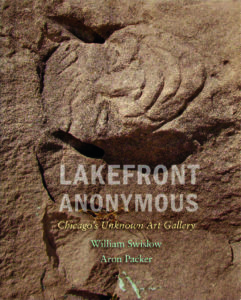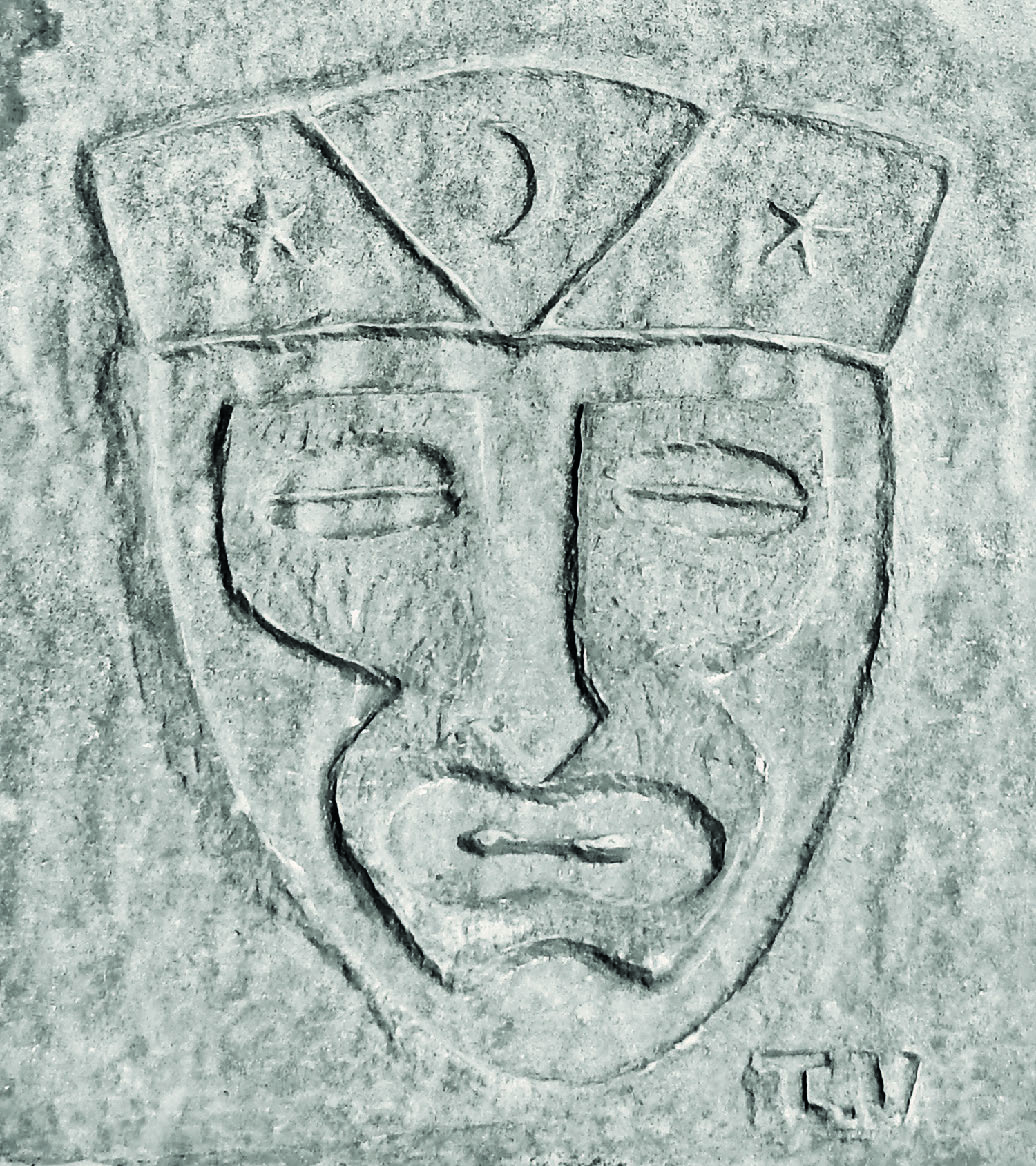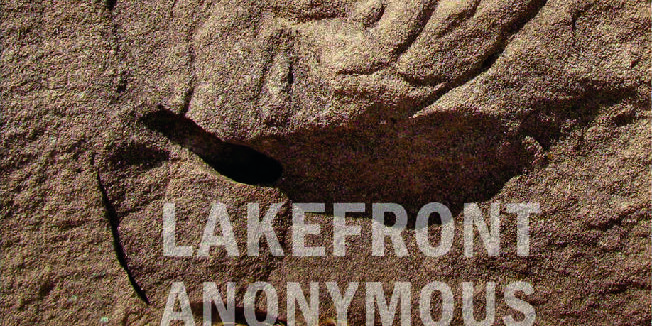Lakefront Anonymous, Chicago’s Unknown Art Gallery
By William Swislow (text and photographs) and Aron Packer (photographs)
Chicago: Interestingideas.com, 2021
Softcover, 160 pages, $40
Reviewed by Joseph Marlin
 Who would have thought there would be a book about graffiti and vernacular stone carvings on Chicago’s lakefront? Not I, and I live here! But William Swislow, an SCA board member, has spent three decades photographing and documenting these works typically created by untrained, anonymous carvers. He considers them a collective work of art produced over a century. Like works in a museum, some are large, some small, and all are, of course, outdoors and subject to wind and rain, ice and snow, freezing and thawing, i.e., Chicago weather.
Who would have thought there would be a book about graffiti and vernacular stone carvings on Chicago’s lakefront? Not I, and I live here! But William Swislow, an SCA board member, has spent three decades photographing and documenting these works typically created by untrained, anonymous carvers. He considers them a collective work of art produced over a century. Like works in a museum, some are large, some small, and all are, of course, outdoors and subject to wind and rain, ice and snow, freezing and thawing, i.e., Chicago weather.
For Swislow, this book is a labor of love. His enthusiasm is apparent, as is his desire to document these carvings. One can identify with his regret that in recent years the City of Chicago and the Army Corps of Engineers have removed many of these monumental blocks holding the carvings in the interest of erosion control and shoreline stabilization, eschewing alternative solutions. These agencies didn’t touch some lakefront areas, while others had their blocks repositioned. About half of these stones remain in more than 25 miles of shoreline, while cement has replaced the rest.
 Swislow’s book raises questions about definitions. What is art? Is it the result of anyone’s effort to be creative? Is graffiti with a heart with arrows and names art? Is vernacular art the best term for these carvings? Most who left their mark were one-time inscribers. Did they think of themselves as artists? But some works were done by persons with training. Was this a macho thing? Did any women carve these stones?
Swislow’s book raises questions about definitions. What is art? Is it the result of anyone’s effort to be creative? Is graffiti with a heart with arrows and names art? Is vernacular art the best term for these carvings? Most who left their mark were one-time inscribers. Did they think of themselves as artists? But some works were done by persons with training. Was this a macho thing? Did any women carve these stones?
 There were initially thousands of carvings, of which about 250 are included in the book. Swislow considers the carvings “one of the world’s great public art treasures” and states “the best of these carvings are stunning, accomplished enough to hold their own among recognized masterpieces of stonework.” Swislow has been a proponent of intuitive art, so his statements are not surprising, but I suspect he knows that sculpture curators in museums would not concur. These works also do not ft the usual definitions of “folk” or “outsider” art. Instead, Swislow suggests some wished only to leave a record of themselves.
There were initially thousands of carvings, of which about 250 are included in the book. Swislow considers the carvings “one of the world’s great public art treasures” and states “the best of these carvings are stunning, accomplished enough to hold their own among recognized masterpieces of stonework.” Swislow has been a proponent of intuitive art, so his statements are not surprising, but I suspect he knows that sculpture curators in museums would not concur. These works also do not ft the usual definitions of “folk” or “outsider” art. Instead, Swislow suggests some wished only to leave a record of themselves.
Let’s take a look at the book’s organization and presentation. The Introduction is a masterfully succinct summary of where these images appear along the lakefront. He emphasizes that this collection should be considered an enormous outdoor gallery, unique in the world. And he laments how little the public has noticed this work and officials’ indifference in removing natural stones with the carvings.
 Most of this 25-mile stretch of the lakefront is a park created from “fill,” some from our famous 1871 fire. The shore is protected by “revetments,” which are massive stones that weigh up to eight tons each. They were built from the 1920s to the 1960s, but problems related to changes in lake levels and rotting support timbers have led to cementing large portions that have produced a sterile, unnatural lakefront. He discusses various non-cement amelioration strategies, none of which have been adopted, and details how activists in my neighborhood, the Hyde Park and University of Chicago communities, successfully resisted “cementification.” Community action can work, but this lakefront area is again under threat.
Most of this 25-mile stretch of the lakefront is a park created from “fill,” some from our famous 1871 fire. The shore is protected by “revetments,” which are massive stones that weigh up to eight tons each. They were built from the 1920s to the 1960s, but problems related to changes in lake levels and rotting support timbers have led to cementing large portions that have produced a sterile, unnatural lakefront. He discusses various non-cement amelioration strategies, none of which have been adopted, and details how activists in my neighborhood, the Hyde Park and University of Chicago communities, successfully resisted “cementification.” Community action can work, but this lakefront area is again under threat.
The book provides the locations of this sprawling gallery, including those painted instead of carved, and is an essential guide for those wanting a personal tour. Swislow also notes where some stones with carvings have been moved. Lastly, before devoting the bulk of the book to more than 200 photos, he pens some interesting stories about carvers he located, especially one who created perhaps the most impressive example.
 The book divides the images into nine sections: Bathing Beauties, Identity and Typography, Figures, Faces, Leisure, Animals, Places, Signs and Symbols, and Other Themes. The book concludes with Aron Packer’s 1991 article about Chicago’s lakefront carvings, the first text to cover the topic, along with Packer’s reflections 30 years later.
The book divides the images into nine sections: Bathing Beauties, Identity and Typography, Figures, Faces, Leisure, Animals, Places, Signs and Symbols, and Other Themes. The book concludes with Aron Packer’s 1991 article about Chicago’s lakefront carvings, the first text to cover the topic, along with Packer’s reflections 30 years later.
Swislow observes the apparent decrease in new carvings, perhaps related to both fewer stones available as canvasses along with people’s changing interests. And yes, it was the young, not the middle-aged or older, who have left their mark predominantly.
Lakefront Anonymous is a nicely bound, attractive, and well-illustrated book. It is a landmark publication since there are no comparable examples of waterfront carvings known in the country. What is pictured ranges from graffiti-like inscriptions to imaginative and beautiful carvings. The totality is impressive, and we should thank Swislow for bringing these works to our attention.
The book concludes with photo captions, listing the photographer. Ideally, it would have been nice to have included each carving’s dimensions. But that’s to be excused as I suspect that Swislow took some at a distance, and I know firsthand that climbing over these rocks can be hazardous. Nevertheless, it’s good to know that Swislow managed to produce an impressive book without breaking his neck creating it.
Joe Marlin is a long-time member of SCA, author of Fading Ads of Chicago, retired administrator of hospital social work departments, and board member of the Hyde Park (Chicago) Historical Society.
This book review originally appeared in the SCA Journal, Fall 2021, Vol. 39, No. 2.The SCA Journal is a semi-annual publication and a member benefit of the Society for Commercial Archeology.
More Book Reviews


